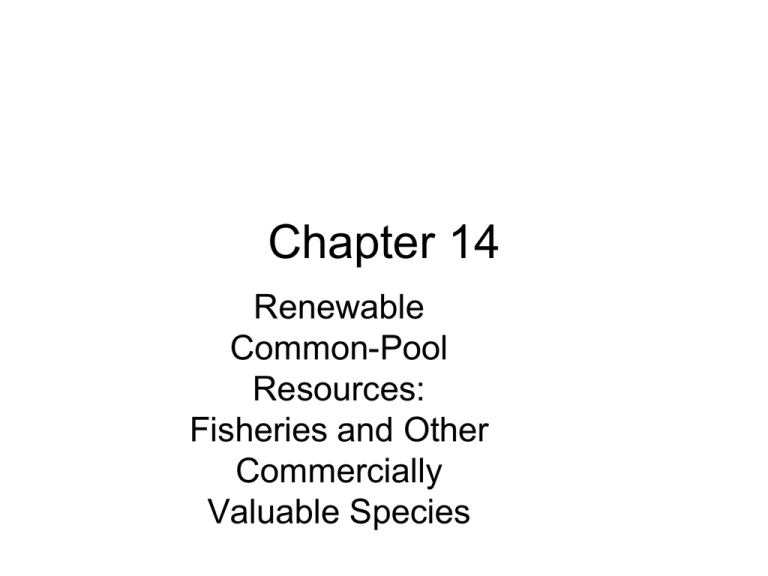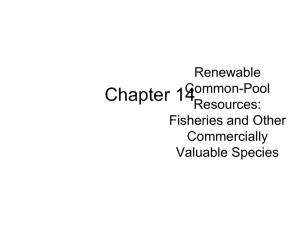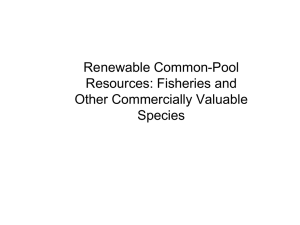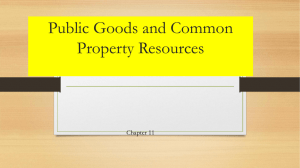Chapter 14 Renewable Common-Pool Resources:
advertisement

Chapter 14 Renewable Common-Pool Resources: Fisheries and Other Commercially Valuable Species FIGURE 14.1 Relationship between the Fish Population and Growth Underlying Assumptions • Assumptions of the economic model are: – price of fish = constant (price-taker) – marginal cost = constant. – amount of fish caught per unit of effort is proportional to the size of the fish population. 3 Possible Solutions • 1. Open (unregulated) Fisheries (Ec) – Catch until total costs exceed revenues (up to zero profits) => ATC(Q) = TotRev(Q) = P*Q • 2. Maximum Sustainable Yield(MSY) (Em) – Largest “harvest” that can be sustained every year (harvest = replacement rate) – Biologist solution • 3. Economically Efficient (Eo) – Maximize Economic Value (MC(Q) = MR(Q) FIGURE 14.2 Efficient Sustainable Yield for a Fishery • Raising the real cost of fishing through regulation is another policy option. – Raising the marginal cost of effort results in a lower harvest and higher stock sizes. – While the policies may result in an efficient catch, they are inefficient because the efficient level of catch is not caught at the lowest possible cost. – Technological innovations have lowered the cost of fishing, offsetting the increases imposed by regulations. Policy Options • Command and Control (Regulation) – Set Quota for number of fish that can be caught • Ignores differences in costs/efficiency of fishermen • Can lead to over capacity (too many boats, too big) • Discarded catch/by-catch issues • Tradable permits (ITQs) – – – – – Determine optimal “harvest” and number of licenses to be issued Divide quota/target by number of license = #fish caught per license Auction or grandfather licenses Allow owners to trade (one-year, or multi-year) Multi-species/by-catch • Taxes – Per unit tax on the #fish caught Individual Transferable Quotas (ITQs) • An efficient quota system will have the following characteristics: – The quotas entitle the holder to catch a specified volume of a specified type of fish. – The total amount of fish authorized by the quotas should be equal to the efficient catch level for that fishery. – The quotas should be freely transferable among fishermen. • Taxes also raise the real cost of fishing, but do so in an efficient manner. – Unlike regulations, the tax can lead to the static-efficient sustainable yield allocation because the tax revenues represent transfer costs and not real-resource costs. – Transfer costs involve the transfer of resources from one part of society to another. – For the individual fisherman, however, a tax still represents an increase in costs. FIGURE 14.7 Effect of Regulation TABLE 14.1 Countries with Individual Transferable Quota Systems Subsidies and Buy Backs • One of management options to reduce overcapacity. – Payments used to buy out excess fishing capacity are useful subsidies, but if additional capacity seeps in over time, they are not as effective as other management measures. • Marine protected areas and marine reserves are areas that prohibit harvesting and are protected from other threats such as pollution. – Marine protected areas are designated ocean areas within which human activity is restricted. – Marine reserves protect individual species by preventing harvests within the reserve boundaries.


